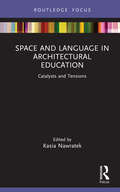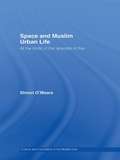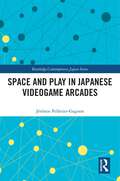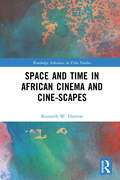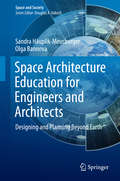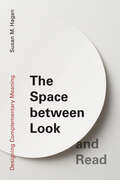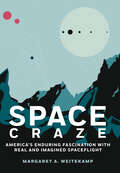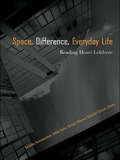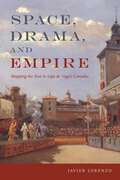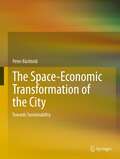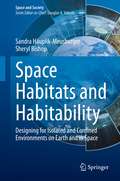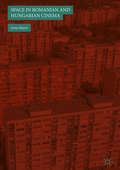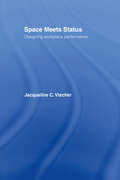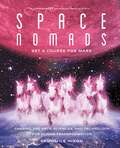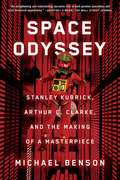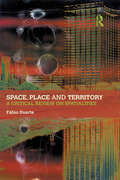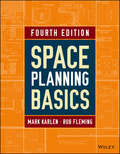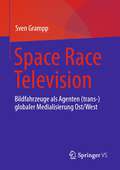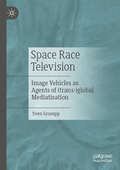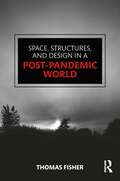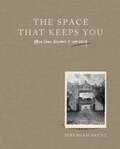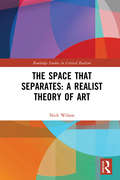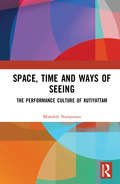- Table View
- List View
Space and Language in Architectural Education: Catalysts and Tensions (Routledge Focus on Design Pedagogy)
by Kasia NawratekArchitects habitually disregard disciplinary boundaries of their profession in search for synergies and inspiration. The realm of language, although not considered to be architects’ natural environment, opens opportunities to further stretch and expand the architectural imagination and the set of tools used in the design process. When used in the context of architectural pedagogy, the exploration of the relationship between space and language opens the discussion further to include the reflection on the design studio structure, the learning process in creative subjects and the ethical dimension of architectural education. This book offers a glimpse into architectural pedagogies exploring the relationship between space and language, using literary methods and linguistic experiments. The examples discuss a wide range of approaches from international perspective, exploring opportunities and challenges of engaging literary methods and linguistic experiments in architectural education. The theme of Catalysts discusses the use of literary methods in architectural pedagogy, where literary texts are used to jumpstart and support the design process, resulting in deeply contextual approaches capable of subverting embedded hierarchies of the design studio. Tensions explore the gap between the world and its description, employing linguistic experiments and literary methods to enrich and expand the architectural vocabulary to include the experience of space in its infinite complexity. This book will be useful for innovators in architectural education and those seeking to expand their teaching practice to incorporate literary methods, and to creatives interested in making teaching a part of their practice. It may also appeal to students from design-based disciplines with an established design studio culture, demonstrating how to use narrative, poetry and literature to expand and feed your imagination.
Space and Muslim Urban Life: At the Limits of the Labyrinth of Fez (Culture and Civilization in the Middle East)
by Simon O'MearaThis book develops academic understanding of Muslim urban space by pursuing the structural logic of the premodern Arab-Muslim city, or medina. With particular reference to The Book of Walls, an historical discourse of Islamic law whose primary subject is the wall, the book determines the meaning of a wall and then uses it to analyze the space of Fez. One of a growing number of studies to address space as a category of critical analysis, the book makes the following contributions to scholarship. Methodologically, it breaks with the tradition of viewing Islamic architecture as a well-defined object observed by a specialist at an aesthetically directed distance; rather, it inhabits the logic of this architecture by rethinking it discursively from within the culture that produced it. Hermeneutically, it sheds new light on one of North Africa's oldest medinas, and thereby illuminates a type of environment still common to much of the Arab-Muslim world. Empirically, it brings to the attention of mainstream scholarship a legal discourse and aesthetic that contributed to the form and longevity of this type of environment; and it exposes a preoccupation with walls and other limits in premodern urban Arab-Muslim culture, and a mythical paradigm informing the foundation narratives of a number of historic medinas. Presenting a fresh perspective for the understanding of Muslim urban society and thought, this innovative study will be of interest to students and researchers of Islamic studies, architecture and sociology.
Space and Play in Japanese Videogame Arcades (Routledge Contemporary Japan Series)
by Jérémie Pelletier-GagnonThis book presents a scholarly investigation of the development and culture of Japanese videogame arcades, both from a historical and contemporary point of view.Providing an overview of the historical evolution of public amusement spaces from the early rooftop amusement spaces from the early nineteenth century to the modern multi‑floor and interconnected arcade complexes that characterize the urban fabric of contemporary Japan, the book argues that arcade videogames and their associated practices must be examined in the context in which they are played, situated in the interrelation between the game software, the cabinets as material conditions of play, and the space of the venue that frames the experience. Including three case studies of distinct and significant game centres located in Tokyo and Kyoto, the book addresses of play in public, including the notion of performance and observation as play practices, spatial appropriation, as well as the compartmentalization of the play experience.In treating videogames as sets of circumstances, the book identifies the opportunities for ludic practices that videogame arcades provide in Japan. As such, it will appeal to students and scholars of Game Studies and Digital Media Studies, as well as those of Japanese Culture and Society.
Space and Time in African Cinema and Cine-scapes (Routledge Advances in Film Studies)
by Kenneth W. HarrowThis book is the first of its kind to bring basic notions of contemporary physics to bear on African cine-scapes. In this book, renowned African cinema scholar Kenneth W. Harrow presents unique new ways to think about space and time in film, with a specific focus on African and African diasporic cinema. Through a series of case studies, he explores how cinema creates and represents time and space and, more specifically, how a cinema centered in African landscapes and figures accomplishes this. He reflects on the issues and problems posed by scientists when faced with the basic questions of what space and time are and their solutions or conclusions, giving both film studies and African studies scholars access to new ways to formulate their thinking about African cine-scapes. Working beyond the limits of a framework based in a postcolonial and cultural understanding of time and space, Harrow demonstrates how a scientific understanding of time and space can open up new approaches to African cinema and cinema in general. A unique, interdisciplinary book that encourages brand new ways to approach cinematic texts and, specifically, African cine-scapes.
Space Architecture Education for Engineers and Architects
by Sandra Häuplik-Meusburger Olga BannovaThis book considers two key educational tools for future generations of professionals with a space architecture background in the 21st century: (1) introducing the discipline of space architecture into the space system engineering curricula; and (2) developing space architecture as a distinct, complete training curriculum. Professionals educated this way will help shift focus from solely engineering-driven transportation systems and "sortie" missions towards permanent off-world human presence. The architectural training teaches young professionals to operate at all scales from the "overall picture" down to the smallest details, to provide directive intention-not just analysis-to design opportunities, to address the relationship between human behavior and the built environment, and to interact with many diverse fields and disciplines throughout the project lifecycle. This book will benefit individuals and organizations responsible for planning transportation and habitat systems in space, while also providing detailed information on work and design processes for architects and engineers.
The Space between Look and Read: Designing Complementary Meaning
by Susan M. HaganUnleashing the potential that can be found in the space between words and images.Designers have long understood that image, text, and typeface can work together to produce new meanings, creating semiotic registers impossible to achieve with image or text alone. In The Space Between Look and Read, a study of complementary meaning in design, Susan Hagan presents a framework, called Inter-play, which explains how these new meanings emerge. Inter-play is not simply an analytical tool; it is also a method for using complementary meaning to encourage critical thinking in design audiences. Drawing from cognitive psychology, art theory, discourse analysis, design, and rhetoric, Hagan breaks down the synthesis of looking and reading into a complex series of registers, which are revealed through examples of excellent design. Thus, the book is both a theoretical exploration of how designers communicate and a casebook in communication well achieved. From the physiology of vision to the limits of language, from Allan Paivio to Uwe Loesch, The Space Between Look and Read expands our understanding of complementary design and argues that by engaging audiences through multiple cognitive registers, complementary design serves as a cognitive tool, helping audiences reach new conclusions about complex problems.
Space Craze: America’s Enduring Fascination with Real and Imagined Spaceflight
by Margaret A. WeitekampA space historian's tour through astounding spaceflight history and the Smithsonian's collection of space and science fiction memorabiliaSpanning from the 1929 debut of the futuristic Buck Rogers to present-day privatization of spaceflight, Space Craze celebrates America's endless enthusiasm for space exploration. Author Margaret Weitekamp, curator at the Smithsonian's National Air and Space Museum, writes with warmth and personal experience to guide readers through extraordinary spaceflight history while highlighting objects from the Smithsonian's spaceflight collection. Featuring historical milestones in space exploration, films and TV shows, literature and comic strips, toys and games, and internet communities, Space Craze is a sci-fi lover's dream. The book investigates how spaceflight, both real and imagined, has served as the nexus where contemporary American concerns, such as race, gender, sexuality, freedom, and national identity, have been explored and redefined. Chronological chapters include: Chapter 1: Buck Rogers, Ray Guns, and the Space FrontierChapter 2: Space Forts, Television, and the Cold War MindsetChapter 3: John Glenn, the Apollo Program, and Fluctuating Spaceflight EnthusiasmChapter 4: Star Trek, Star Wars, and Burgeoning FandomsChapter 5: Generation X, the Space Shuttle, and Promoting EducationChapter 6: Space Stations, Spaceflight Enthusiasm, and Online FandomChapter 7: Streaming Services, Battling Billionaires, and Accelerated ChangeFrom the almost 650 million viewers who tuned in to watch the first steps on the Moon, to the ardent Star Trek fandom that burgeoned into a cultural force, Space Craze taps into the country&’s enduring love affair with space.
Space, Difference, Everyday Life: Reading Henri Lefebvre
by Kanishka Goonewardena Stefan Kipfer Richard Milgrom Christian SchmidIn the past fifteen years, Henri Lefebvre’s reputation has catapulted into the stratosphere, and he is now considered an equal to some of the greats of European social theory (Bourdieu, Deleuze, Harvey). In particular, his work has revitalized urban studies, geography and planning via concepts like; the social production of space, the right to the city, everyday life, and global urbanization. Lefebvre’s massive body of work has generated two main schools of thought: one that is political economic, and another that is more culturally oriented and poststructuralist in tone. Space, Difference, and Everyday Life merges these two schools of thought into a unified Lefebvrian approach to contemporary urban issues and the nature of our spatialized social structures.
Space, Drama, and Empire: Mapping the Past in Lope de Vega's Comedia (Campos Ibéricos: Bucknell Studies in Iberian Literatures and Cultures)
by Javier LorenzoSpanish poet, playwright, and novelist Félix Lope de Vega (1562–1635) was a key figure of Golden Age Spanish literature, second only in stature to Cervantes, and is considered the founder of Spain’s classical theater. In this rich and informative study, Javier Lorenzo investigates the symbolic use of space in Lope’s drama and its function as an ideological tool to promote an imagined Spanish national past. In specific plays, this book argues, historical landscapes and settings were used to foretell and legitimize the imperial present in Hapsburg Spain, allowing audiences to visualize and plot, as on a map, the country’s expansionist trajectory throughout the centuries. By focusing on connections among space, drama, and empire, this book makes an important contribution to the study of literature and imperialism in early modern Spain and equally to our understanding of the role and political significance of spatiality in Siglo de Oro comedia.
The Space-Economic Transformation of the City
by Peter BächtoldCity planning is the key-stone to tackle the question of climate-change and to involve adequate action. In Part I of this book, the theory of space-economy is presented. Opening up a new conceptual and operational toolbox for policy makers, practitioners and scholars, the theory of space-economy is based on a rigorously structured thinking and acting in the field of sustainable urban planning and architecture. Europe has the greatest experience in sustainable city planning worldwide. In Part II, four of the most remarkable experiences (Vauban in Freiburg i.B., Kronsberg in Hannover, Western Harbour in Malmö, Hammarby Sjöstad in Stockholm) are presented, dissected conceptually and operationally a radically new way. The interest of the approach is not limited to European countries. In Part III is developed a project in Asia, in Ho Chi Minh City, faced with dramatic threats due to climate change and rapidly growing tidal and sea-level rise. Based on the experiences presented in Part II, the approach is integrated in this completely different context, thus becoming fully effective at a much bigger scale.
Space Grid Structures
by John ChiltonA space frame is a three-dimensional framework for enclosing spaces in which all members are interconnected and act as a single entity. A benefit of this type of structure is that very large spaces can be covered, uninterrupted by support from the ground. John Chilton's book provides an up-to-date assessment of the use of space grid structures in buildings by reviewing methods of construction, various systems available and detailed studies of the use of space grids in modern buildings. The technical level is aimed at professional and student architects and engineers worldwide and it also serves as a useful construction manual. John Chilton is an engineer, currently teaching architectural students at Nottingham University where he is a senior lecturer. He has also undertaken considerable research in this field.
Space Habitats and Habitability: Designing for Isolated and Confined Environments on Earth and in Space (Space and Society)
by Sandra Häuplik-Meusburger Sheryl BishopThis book explores creative solutions to the unique challenges inherent in crafting livable spaces in extra-terrestrial environments. The goal is to foster a constructive dialogue between the researchers and planners of future (space) habitats. The authors explore the diverse concepts of the term Habitability from the perspectives of the inhabitants as well as the planners and social sciences.The book provides an overview of the evolution and advancements of designed living spaces for manned space craft, as well as analogue research and simulation facilities in extreme environments on Earth. It highlights how various current and future concepts of Habitability have been translated into design and which ones are still missing. The main emphasis of this book is to identify the important factors that will provide for well-being in our future space environments and promote creative solutions to achieving living spaces where humans can thrive. Selected aspects are discussed from a socio-spatial professional background and possible applications are illustrated.Human factors and habitability design are important topics for all working and living spaces. For space exploration, they are vital. While human factors and certain habitability issues have been integrated into the design process of manned spacecraft, there is a crucial need to move from mere survivability to factors that support thriving. As of today, the risk of an incompatible vehicle or habitat design has already been identified by NASA as recognized key risk to human health and performance in space. Habitability and human factors will become even more important determinants for the design of future long-term and commercial space facilities as larger and more diverse groups occupy off-earth habitats. The book will not only benefit individuals and organizations responsible for manned space missions and mission simulators, but also provides relevant information to designers of terrestrial austere environments (e.g., remote operational and research facilities, hospitals, prisons, manufacturing). In addition it presents general insights on the socio-spatial relationship which is of interest to researchers of social sciences, engineers and architects.
Space in Romanian and Hungarian Cinema
by Anna BatoriThis book examines the structuring of space in Romanian and Hungarian cinema, and particularly how space is used to express the deep imprint of a socialist past on a post-socialist present. It considers this legacy of the Eastern European socialist regimes by interrogating the suffocating, tyrannical and enclosing structures that are presented in film. By tracing such paradigmatic models as horizontal and vertical enclosure, this book aims to show how enclosed spatial structuring restages the post-socialist era to produce an implicit and collective form of remembrance. While closely scrutinizing the interplay of location and image, Space in Romanian and Hungarian Cinema offers a new approach to the cinema of the region, which unites the filmic productions under a defined, post-socialist Eastern European spatial umbrella. By simultaneously portraying the gloom of a socialist past, while also conveying a sense of longing for a pre-capitalist era, these films convey how sense of unity and also ambivalence is a defining hallmark of Eastern European cinema.
Space Meets Status: Designing Workplace Performance
by Jacqueline VischerShowing how worker productivity and stress levels are affected by factors such as lighting, ventilation, temperature, noise and layout, this book demonstrates how the technical aspects of human comfort do not always tally with users' perceptions and behaviour. With vivid examples and case studies to illustrate how space is a corporate resource rather than simply overhead, Vischer reveals how companies can improve their ability to make design decisions on how best to accommodate their employees in a high quality workspace.
Space Nomads: Chasing the Arts, Sciences, and Technology for Human Transformation
by Camomile HixonTransform Your Mind. Expand Your Universe. Reach for Mars. Imagine a better tomorrow with interstellar essays and art—drawing on the aspirational futurism that fuels Star Trek, The Martian, and 2001: A Space Odyssey, renowned contemporary artist Camomile Hixon reminds us that by reaching for the stars, we can chase our full potential beyond Earth, while also transforming ourselves and our understanding of the Pale Blue Dot we call home.We stand at the threshold of interplanetary travel: SpaceX rockets are now routinely leaving Earth and NASA&’s new Perseverance rover is searching for signs of ancient life on the Red Planet. Not since the moon landing in 1969 has space—or the promise of a transformational future for humankind—felt so close. Do we dare to reach for it? Yearning to know the stars has long united humanity and ignited our imaginations. And while here on Earth we grapple with deep unrest—economic struggle, political upheaval, gender discrimination, pandemics, racial tensions, climate change—the potential of a colony on Mars has sparked a new, universal hope and a heightened sense of collective purpose as we discover our ultimate destiny beyond Earth&’s orbit. Celebrating the limitless potential of space and the human spirit, Hixon&’s indelible essays and fantastical works of art invite us to imagine a transcendent future where we reach together for absolute freedom, unconditional love, and wellness on our grand quest for world peace. Weaving science, history, art, and philosophy with meditations on higher consciousness inspired by seeing the Earth from Space, Space Nomads is a book of unbridled optimism for the future.
Space Odyssey: Stanley Kubrick, Arthur C. Clarke, and the Making of a Masterpiece
by Michael BensonThe definitive story of the making of 2001: A Space Odyssey, acclaimed today as one of the greatest films ever made, and of director Stanley Kubrick and writer Arthur C. Clarke—&“a tremendous explication of a tremendous film….Breathtaking&” (The Washington Post).Fifty years ago a strikingly original film had its premiere. Still acclaimed as one of the most remarkable and important motion pictures ever made, 2001: A Space Odyssey depicted the first contacts between humanity and extraterrestrial intelligence. The movie was the product of a singular collaboration between Stanley Kubrick and science fiction visionary Arthur C. Clarke. Fresh off the success of his cold war satire Dr. Strangelove, Kubrick wanted to make the first truly first-rate science fiction film. Drawing from Clarke&’s ideas and with one of the author&’s short stories as the initial inspiration, their bold vision benefited from pioneering special effects that still look extraordinary today, even in an age of computer-generated images. In Space Odyssey, author, artist, and award-winning filmmaker Michael Benson &“delivers expert inside stuff&” (San Francisco Chronicle) from his extensive research of Kubrick&’s and Clarke&’s archives. He has had the cooperation of Kubrick&’s widow, Christiane, and interviewed most of the key people still alive who worked on the film. Drawing also from other previously unpublished interviews, Space Odyssey provides a 360-degree view of the film from its genesis to its legacy, including many previously untold stories. And it features dozens of photos from the making of the film, most never previously published. &“At last! The dense, intense, detailed, and authoritative saga of the making of the greatest motion picture I&’ve ever seen…Michael Benson has done the Cosmos a great service&” (Academy Award-winning actor Tom Hanks).
Space, Place and Territory: A Critical Review on Spatialities
by Fabio DuarteSpace, place and territory are concepts that lie at the core of geography and urban planning, environmental studies and sociology. Although space, place and territory are indeed polysemic and polemic, they have particular characteristics that distinguish them from each other. They are interdependent but not interchangeable, and the differences between them explain how we simultaneously perceive, conceive and design multiple spatialities. After drawing the conceptual framework of space, place and territory, the book initially explores how we sense space in the most visceral ways, and how the overlay of meanings attached to the sensorial characteristics of space change the way we perceive it – smell, spatial experiences using electroence phalography, and the changing meaning of darkness are discussed. The book continues exploring cartographic mapping not as a final outcome, but rather as an epistemological tool, an instrument of inquiry. It follows on how particular ideas of space, place and territory are embedded in specific urban proposals, from Brasília to the Berlin Wall, airports and infiltration of digital technologies in our daily life. The book concludes by focusing on spatial practices that challenge the status quo of how we perceive and understand urban spaces, from famous artists to anonymous interventions by traceurs and hackers of urban technologies. Combining space, place and territory as distinctive but interdependent concepts into an epistemological matrix may help us to understand contemporary phenomena and live them critically.
Space Planning Basics
by Rob Fleming Mark KarlenConquer the complexity of interior design with a logical, methodical approach Space Planning Basics is a definitive introduction and principle resource for thousands of designers. With step-by-step methodology based on the author's several decades of design experience, this authoritative guide has become the de facto reference for an entire generation of designers. This updated fourth edition includes digitized drawings, diagrams, and matrices throughout, and newly added supplemental photographs. The text has been revised to reflect the latest developments in sustainable and universal design, including coverage of daylighting, benchmarking, LEED system standards, and green code issues. The companion website provides AutoCAD files, intrustor videos and matrices to give you a deeper real-world understanding of the design process. This book is perfect preparation for the NCIDQ exam. Proper space planning goes way beyond sketching a preliminary floor plan. Successful implementation includes a balanced integration of code compliance, system support, and adherence to the client's functional needs. Sustainability adds a new, important layer of complexity. This book shows you how to approach space planning in a way that ensures all considerations are met, and nothing gets lost in the process. Adopt an organized and comprehensive planning methodology Work effectively with dimensionally challenging spaces Consider building systems, codes, lighting, acoustics, and more Develop advanced skills and conquer new challenges Space planning encompasses many components and processes, making a comprehensive reference necessary for mastery of the field. Space Planning Basics is a thorough, methodical resource that gets you started on the right track, with plenty of room for creativity.
Space Race Television: Bildfahrzeuge als Agenten (trans-)globaler Medialisierung Ost/West
by Sven GramppDer Band bietet eine medientheoretisch ausgerichtete Perspektive auf das Space Race. Analysiert werden Spielfilme, Dokumentationen, Live-Berichterstattung im Fernsehen, Magazine, Briefmarken, Plakate, Konfettiparaden, die das Space Race in je spezifischer Weise ins Bild setzten und von ‚Ost‘ nach ‚West‘ und von ‚West‘ nach ‚Ost‘ transnational über den ‚Eisernen Vorhang‘ hinweg in Umlauf brachten. Gezeigt wird, wie sich die Berichterstattung über das Space Race dabei zwischen 1955 und 1975 als globalisierende Bilder-Verflechtungsgeschichte während des Kalten Krieges nacherzählen lässt.
Space Race Television: Image Vehicles as Agents of (trans-)global Mediatisation
by Sven GramppThis volume offers a media-theoretically oriented perspective on the Space Race. It analyzes feature films, documentaries, live television coverage, magazines, stamps, posters, ticker-tape parades. They visualized the Space Race in a specific way and circulated it transnationally from 'East' to 'West' and from 'West' to 'East' across the 'Iron Curtain'. It will be shown how reporting on the Space Race between 1955 and 1975 can be explained as a globalizing history of the intertwining of images during the Cold War.
Space, Structures and Design in a Post-Pandemic World
by Thomas FisherPandemics have long-term effects on how we live and work, and the COVID-19 pandemic was no exception, accelerating us into a digital economy, in which people increasingly work, shop, and learn online, transforming how we use space in-person and remotely. Space, Structures, and Design in a Post-Pandemic World explores the rebalancing of our physical and digital interactions and what it means for the built environment going forward. This book examines the effect of the pandemic on our use of land, interior space, energy, and transportation, as well as on our approach to design, wealth, work, and practice. Author Thomas Fisher also discusses the plagues of institutional racism and climate change that coincided with the COVID-19 pandemic and how these were interrelated. At the same time as all of this, the automation of all or part of many jobs continued unabated, eliminating much of the work that people did before COVID-19 arrived. This text discusses how we might leverage the under-utilized human talent and material assets all around us to rebuild our communities and our economy in more creative ways for a more equitable, resilient future. Space, Structures, and Design in a Post-Pandemic World will influence anyone interested in how design thinking can transform how we see the world and those looking for new ways to understand what the COVID-19 pandemic means and what opportunities it creates for our environments.
The Space That Keeps You: When Home Becomes a Love Story
by Jeremiah BrentInterior designer and television host Jeremiah Brent explores the emotional meaning of home in this warm and inviting book that illuminates what make peoples’ spaces so personally significant.For many of us, our houses are more than just where we hold our belongings. They are reflections of who we are and where we’ve been. They represent our aesthetics, our personalities – provide us with purpose and intention, and if we’re lucky, a safe space to live and create. For years, Jeremiah Brent and his family lived in one beautiful home after the next. Yet after a short time, they always felt the pull to move on. Curious to understand why, he embarked on a deeply personal mission to discover what makes a home a space that keeps you.The Space That Keeps You isn’t just a study of beautiful interior design; it’s an emotional design book that explores what gives spaces meaning. Through candid conversations with nine individuals and families varying in backgrounds, lifestyles, and geographic locations, Jeremiah reveals how and why the spaces we inhabit come to feel like they truly belong to us—the memories, emotions, and stories that shape what home signifies.He introduces memorable people like the artist couple James and Alexandra Brown and their children who made an abandoned plot in Merida, Mexico their accidental paradise, and Tracy and Brian Robbins who found refuge during the pandemic in a serene single-story home in Montecito surrounded by fields of lavender. He illuminates a personal side of Oprah Winfrey as she speaks to the importance of nature in her dream of home, and describes the story of Giberto and Bianca Arrivabene, who fought to hold onto their family’s historic Venetian palazzo. Their stories are bookended by Jeremiah’s recollections of his own journey defining home with his husband, fellow interior designer and television personality Nate Berkus, and their two children.Filled with intimate, meaningful details—from the kitchen that now nourishes the grandchildren of the adoring couple who first cooked there fifty years ago to the beams of one apartment’s walls that are etched with hearts to literally represent the love that fills it—and accompanied by 300 inviting and inspiring color photographs— The Space That Keeps You illustrates the essence of what makes a house a home. Just like Jeremiah himself, readers will leave this book with a newfound appreciation for the places that connect and shape us.
The Space that Separates: A Critical Realist Aesthetics (Routledge Studies in Critical Realism)
by Nick WilsonThe Space that Separates: A Realist Theory of Art radically challenges our assumptions about what art is, what art does, who is doing it, and why it matters. Rejecting the modernist and market-driven misconception that art is only what artists do, Wilson instead presents a realist case for living artfully. Art is defined as the skilled practice of giving shareable form to our experiences of being-in-relation with the real; that is to say, the causally generative domain of the world that extends beyond our direct observation, comprising relations, structures, mechanisms, possibilities, powers, processes, systems, forces, values, ways of being. In communicating such aesthetic experience we behold life’s betweenness – "the space that separates", so coming to know ourselves as connected. Providing the first dedicated and comprehensive account of art and aesthetics from a critical realist perspective – Aesthetic Critical Realism (ACR), Wilson argues for a profound paradigm shift in how we understand and care for culture in terms of our system(s) of value recognition. Fortunately, we have just the right tool to help us achieve this transformation – and it’s called art. Offering novel explanatory accounts of art, aesthetic experience, value, play, culture, creativity, artistic truth and beauty, this book will appeal to a wide audience of students and scholars of art, aesthetics, human development, philosophy and critical realism, as well as cultural practitioners and policy-makers.
Space, Time and Architecture: The Growth of a New Tradition, Fifth Revised and Enlarged Edition (The\charles Eliot Norton Lectures #1938-1939)
by Sigfried GiedionA milestone in modern thought, Space, Time and Architecture has been reissued many times since its first publication in 1941 and translated into half a dozen languages. In this revised edition of Sigfried Giedion’s classic work, major sections have been added and there are 81 new illustrations. The chapters on leading contemporary architects have been greatly expanded. There is new material on the later development of Frank Lloyd Wright and the more recent buildings of Walter Gropius, particularly his American Embassy in Athens. In his discussion of Le Corbusier, Mr. Giedion provides detailed analyses of the Carpenter Center at Harvard University, Le Corbusier’s only building in the United States, and his Priory of La Tourette near Lyons. There is a section on his relations with his clients and an assessment of his influence on contemporary architecture, including a description of the Le Corbusier Center in Zurich (designed just before his death), which houses his works of art. The chapters on Mies van der Rohe and Alvar Aalto have been brought up to date with examples of their buildings in the sixties. There is an entirely new chapter on the Danish architect Jørn Utzon, whose work, as exemplified in his design for the Sydney Opera House, Mr. Giedion considers representative of post–World War II architectural concepts. A new essay, “Changing Notions of the City,” traces the evolution of the structure of the city throughout history and examines current attempts to deal with urban growth, as shown in the work of such architects as José Luis Sert, Kenzo Tange, and Fumihiko Maki. Mr. Sert’s Peabody Terrace is discussed as an example of the interlocking of the collective and individual spheres. Finally, the conclusion has been enlarged to include a survey of the limits of the organic in architecture.
Space, Time and Ways of Seeing: The Performance Culture of Kutiyattam
by Mundoli NarayananThis volume explores the constitutive role played by space in the performance of Kutiyattam. The only surviving form of Sanskrit theatre, Kutiyattam is distinctive in terms of its performance conventions and its unique culture of extensive elaboration and interpretation. Drawing upon the concepts of phenomenology on the processes of perception, particularly on the works of Edmund Husserl, Martin Heidegger and Maurice Merleau-Ponty, it analyses the role of space in the communicative structures of performance of Kutiyattam and its contribution to the production of meaning in theatre, especially in the context of contemporary theatre. The book explores the theatrical event as a phenomenon that comes into existence through a triangular relationship among the ‘ways of being’ of the performers, the ‘ways of seeing’ of the audience, and the space which brings them together. Based on this formulation, Kutiyattam is approached as a ‘theatre of elaboration,’ made possible by the ‘intimate,’ ‘proximal’ ways of seeing of the audience, in the particular theatrical space of the kūttampalaṃs, the temple theatres, where Kutiyattam has customarily been performed for more than five centuries. This volume will be of great interest to scholars and researchers of cultural studies, theatre and performance studies, cultural anthropology, phenomenology and South Asian studies.
